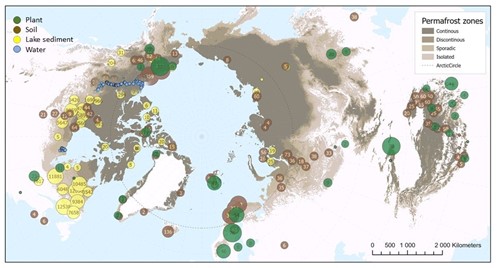Mercury is a global pollutant of concern due to its toxicity to humans and wildlife. Mercury has
an atmospheric lifetime of about six months, allowing it to be transported and deposited in far removed ecosystems. High levels have been found in permafrost regions despite their remoteness from known natural and anthropogenic sources.
PermHg aims to synthesize mercury data in soils, plants, and water from permafrost regions in a publicly available database. To date, PermaHg has compiled all known mercury and geospatial data in permafrost soils and discussed data analysis and a revised global estimate of mercury stored in permafrost soils. This work is important to understand how climate change and permafrost thaw will impact the cycling and storage of mercury.
In May 2024, researchers from eight organizations and three countries met to discuss data collection and formatting, and support for geospatial software in the database. In 2025, their goal is to disseminate findings at the American and European Geophysical Unions and in a
peer-reviewed journal article. This will contribute to the ongoing effort aimed at improving mercury data accessibility and predictions of future ecological impacts.
Highlights and Updates – March 2025
In December of 2024, several members of our Action Group attended the American Geophysical Union conference in Washington D.C. Christine Olson presented a poster titled “PermHg: A database of mercury concentrations in northern permafrost regions”. The poster our latest updates, including a map displaying nearly 150,000 measurements of mercury concentrations in permafrost soils, water, and vegetation worldwide.

Contact: Christine Olson (christine.olson@colorado.edu)
Reports:
Application